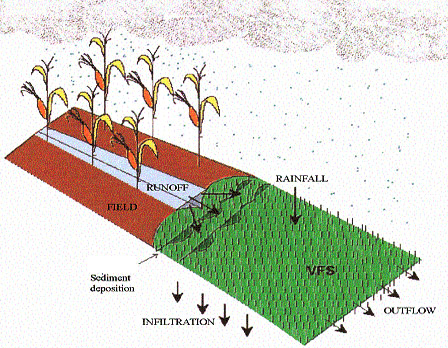 Filter strips are vegetated sections of land designed to accept runoff as overland sheet flow. In order to be effective they should be 5-15 metres wide and they may adopt any natural vegetated form, from grassy meadow to small wood. The wider the strip and the more dense the plant cover the better the pollutant removal.
Filter strips are vegetated sections of land designed to accept runoff as overland sheet flow. In order to be effective they should be 5-15 metres wide and they may adopt any natural vegetated form, from grassy meadow to small wood. The wider the strip and the more dense the plant cover the better the pollutant removal.
Filter strips are best employed at the upstream end of the drainage system, accepting runoff from small areas (up to 2 hectares) directly, for example, before it is concentrated in a drainage system. Road runoff can also be treated in this manner, provided the road/filter strip boundary is designed so that it does not become blocked by sediment or vegetation.
Filter strips can be used effectively to remove excess solids and pollutants before discharge to an infiltration system. They may preserve the character of riparian zones and prevent erosion along stream banks by reducing flow velocities and spreading the flow across a wide area. They also provide an excellent wildlife habitat when used in this way.
View sites in Wales with a Filter strip system.









